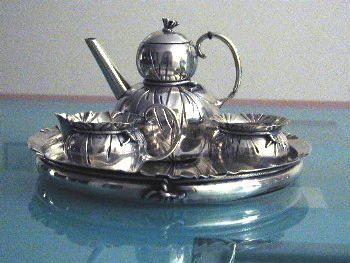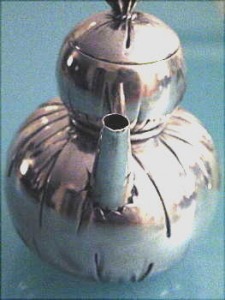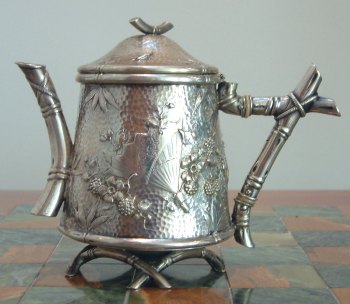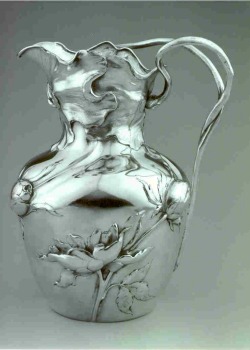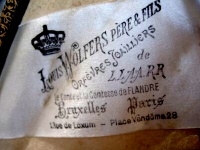 ASSOCIATION OF SMALL COLLECTORS OF ANTIQUE SILVER
ASSOCIATION OF SMALL COLLECTORS OF ANTIQUE SILVERASCAS
| article # 51 |
|
next |
previous |
(click on photos to enlarge images)PHILIPPE WOLFERS' JAPONISM IN BELGIUM
Do women art lovers and silver experts have another approach to
History of Art? |
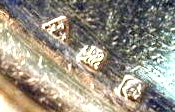 |
hallmarks |
 |
800 MILL |
|
Germany hallmark
|
Wolfers Frères:
|
Belgium: 800/1000 standard
|
My personal intuition made me ascribe this
design to Philippe Wolfers for different reasons.
Ph. Wolfers came from a dynasty of Belgian silversmiths and
jewelers of German and Dutch origins.
Ph. Wolfers took lectures in drawing and sculpture at the
Academie Royale des Beaux Arts in Brussels, where he also formed
lifelong friendship with other artists, many of which would
become colleagues in later artistic ventures.
He entered his father’s workshop at the age of 17 and trained as
apprentice there.
The Japanese style became more pronounced
when Wolfers started to give priority to curve and sweeping
lines.
By the end of 1880 the Japanese style was fully developed, since
1878 Tiffany in New York and Philippe Wolfers in Brussels
created forms totally inspired by nature with asymmetrical
floral or vegetal ornamentation.
Tea and coffeepots did lose their classical forms and just
blossomed in untraditional vegetal forms.
Vivid discussions and many illustrations
of Wolfers’ work are found in the Revue des Arts Decoratifs and
in the Revue L’Art Ancien et Moderne.
More involved studies show that Belgium was one of the
birthplaces of the sources of Art Nouveau.
At the time of those two Universal Exhibitions (1894 and 1897)
the personal creations of Ph. Wolfers merged with the
achievements of the Wolfers House of which he assumed exclusive
artistic direction.
His aim was to free himself from the commercial aspect of
silversmithing.
He created his own workshop employing highly skilled
silversmiths, engravers, sculptors, enamellists, ivory carvers
and lapidaries. In this selected environment he then created and
had executed his line of 'Pièces Uniques' (unique pieces), which
he signed with his own monogram – PW.
The quite unexpected design imitating ‘cloth tied by a rope’ of
the set at hand lets us draw design parallels between Philippe
Wolfers and American production such as works by Tiffany, Gorham
or Whiting, in a more ‘trompe l’oeil’ style, - see also the
coffeepot made by Whiting Mfg. Co., New York, ca 1883 - Dallas
Museum of Art. - Book ref : ‘Silver in America’, page 169.)
More about ‘The Wolfers'
Wolfers became one of the most famous Belgian and Brussels
silversmith companies of the 19th century, its reputation
comparable to those of Emile Puiforcat, Odiot or Aucoc in Paris,
Garrard in London, Tiffany or Gorham in America.
In the first half of the 19th century, three young German
silversmith brothers, Edouard, Guillaume and Louis Wolfers
established two workshops in Brussels.
In 1852, Louis Wolfers (1820-1892) registered his makers’ mark,
consisting of a letter W above a boar’s head.
After their apprenticeships, his three sons, Philippe, Max and
Robert, were sent to prospect for business in France, Germany,
the Netherlands and Austria.
As a result, the Wolfers firm associated with Bonnebacker of
Amsterdam, P. Krischer in Düsseldorf, Goldschmidt in Köln, and
Friedlander in Berlin. This explains why some German assay and
retailer’s marks are punched with Wolfers silversmith marks.
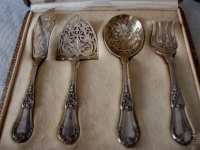 |
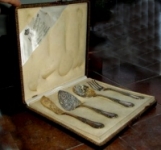 |
At the end of the 19th century ‘Wolfers Frères’ silver was
mostly heavy, cast or hammered; the decoration chased and
engraved.
Wolfers’ workshops employed high skilled workers, there was no
room for low quality stamped production.
At the beginning of the influence of the Japanese style,
Philippe was the artistic director and designer for the family
Wolfers workshop called ‘Wolfers Frères’.
He played a very important role in the development of the Art
Nouveau in Belgium.
Their workshop’s mark was that special ‘triangle with three
stars’ in fact:
three pentacles (5-point stars contained in a triangle), which
is a rare example of a personal mark using Masonic symbols.
And this is the mark we find on the tiny tea or mocha set.
Research work:
Unfortunately there is not much research work about Wolfers
Frères designs. The archives and lots of drawings were scattered
when the ‘House’ Wolfers Frères closed the doors of the workshop
in 1975.
I searched in exhibition catalogues and did not find any
information about the origin of this very peculiar design.
Help Wanted! :
I really wonder how this object came to the US?
So if you do have any information about this design or object,
please don’t hesitate to contact me at: info@silverbel.com
A selection of Bibliography
The Studio - Londres - 1898 - 1899 - 1900 – 1902
The Magazine of Art - Londres: 1899-1901
The Artist - Londres: 1900-1901-1902
The Craftsman Syracuse - New-York: 1904
Sources of Art Nouveau. S.T. Madsen - Philippe Wolfers - New-York 1955
‘Modern Silver 1880-1940’ Mrs Krekel Aalberse-Amsterdam 1989
‘Silver of a New Era’ Museum Boymans – Van Beuningen, Rotterdam and Museum Voor Sierkunst, Gent 1992
